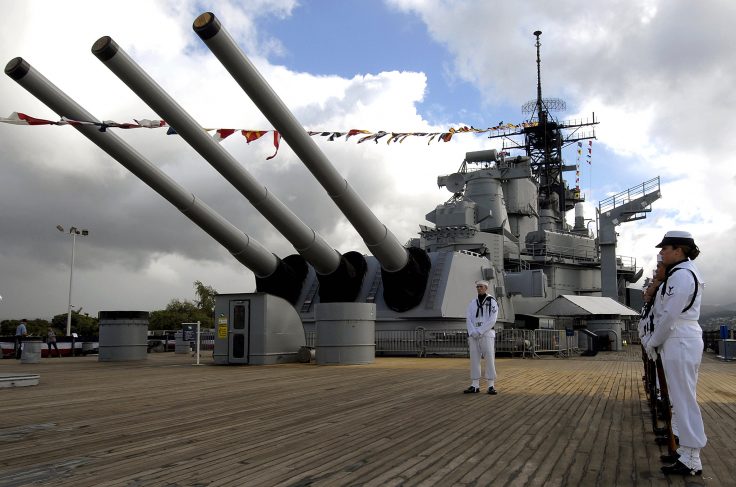British Continued Naval Supremacy and Could Transport 8 5 Million Troops
Culture
How We Achieved Naval Supremacy—And How We Could Lose It
REVIEW: Paul Kennedy's 'Victory at Sea'

• May 30, 2022 5:00 am
Polymathic economist Tyler Cowen recently observed , "as a general rule you can never read enough good books about World War II, even after you feel you have read enough good books about World War II." In Victory at Sea , Paul Kennedy and Ian Marshall created an engaging and interesting work about the most consequential event of the 20th century.
Marshall's art is one of this book's many delights. Kennedy originally planned to write the foreword and accompanying text for his friend's collection of naval paintings, but Marshall's passing made Kennedy set aside other projects to return to World War II. The two pair nicely: Marshall's meticulously detailed paintings illustrate Kennedy's point that, although the production statistics tell part of the war's story, "the deficit in all deterministic explanations—the substructure alters, therefore the superstructure is changed—is that they lack human agency."
The war forced a remarkable change in world politics: After centuries of global domination, the European colonial empires collapsed under Germany's and Japan's combined blows, leaving the United States as the leading global power. As Kennedy argues, this change became manifest in 1943 and was "the natural culmination, though delayed by almost half a century, of the huge shifts in the world's balances once the American continent industrialized."
Japan is the major power American readers will benefit most from studying. Primarily due to interwar arms control treaties, which restricted fleet tonnage and ship size, Britain had the most well-rounded navy, albeit with a weak aircraft carrier wing, while the United States chose not to build up to its treaty limits. Much like the United States today, Japan's navy was less numerous than its Pacific rivals' but it had exquisitely trained naval aviators who flew from grouped aircraft carriers.
Even before the United States entered the war, it was clear that the Americans would be a naval juggernaut. The day the news of France's surrender reached Washington, Congress doubled the Navy's budget request, effectively building from scratch a navy as large as Japan's. In Berlin and Tokyo, timetables shifted accordingly: If they could not lock in their gains quickly, the odds would turn against them.
In the meantime, Britain struggled against the Germans and Italians. Germany's few but powerful surface combatants threatened to break out into the Atlantic until British bombers demonstrated the folly of venturing into the open sea without air cover. In the Mediterranean, the tables were turned: The Royal Navy made forays from Gibraltar and Alexandria to support Greece and resupply Malta, but at immense cost. At one point, the Admiralty counted on only one quarter of the Malta convoys' supplies making it through. Britain pulled off a first when its torpedo bombers ambushed the Italian fleet in port at Taranto, which Japan's strategists studied carefully as they prepared to attack Pearl Harbor.
By mid-1943, the naval war near Europe was effectively over. Germany's U-boats might have starved Britain into submission in 1942 if Hitler had agreed to build more of them, but allied technological advances in cryptography and radar and better convoy tactics blunted the U-boat threat. Landings in North Africa, Sicily, and southern Italy knocked Italy out of the war and allowed the allies relatively free access across the Mediterranean. After the Normandy landings, Britain was able to send a carrier group to the Pacific.
The Pacific's naval battles were the largest and most dramatic of the war. Starting in December 1941, Japan executed one of the most extraordinary campaigns in military history. Simultaneously attacking American and British garrisons from Hong Kong to Hawaii, then sinking British naval reinforcements and conquering Southeast Asia, all while continuing the war in China, Japan in six months rivaled or surpassed every other conqueror. And then, it stopped.
Kennedy argues that the turning point of the Pacific war was not the Battle of Midway—soon after, the U.S. Navy was reduced to only one aircraft carrier—but rather when the fruits of that massive shipbuilding program ventured out of Hawaii in late 1943. In that intervening year, Japan failed to capitalize on American weakness. This is partly because the Americans killed the formidable Admiral Yamamoto, but also because Japan could not replace its lost carriers and air crews fast enough. To compensate, in 1944 Japanese admirals tried to bait the Americans into elaborate traps in the Philippine Sea and Leyte Gulf, but they were mauled by superior American numbers and tactics. By the end of the war, America's formidable new battleships had little to do other than shoot down kamikazes.
World War II is a natural source of triumphalism, but there is a hidden warning within Victory at Sea . China's navy already possesses more ships than ours does, and the Navy's proposed budget will shrink the fleet even further. The current plan is to compensate for China's greater numbers and production with technology and élan. The Japanese tried that too. They lost.
Victory at Sea: Naval Power and the Transformation of the Global Order in World War II
by Paul Kennedy with paintings by Ian Marshall
Yale University Press, 544 pp., $37.50
Mike Watson is the associate director of Hudson Institute's Center for the Future of Liberal Society.
graebnernareptund.blogspot.com
Source: https://freebeacon.com/culture/how-we-achieved-naval-supremacy-and-how-we-could-lose-it/
0 Response to "British Continued Naval Supremacy and Could Transport 8 5 Million Troops"
Post a Comment